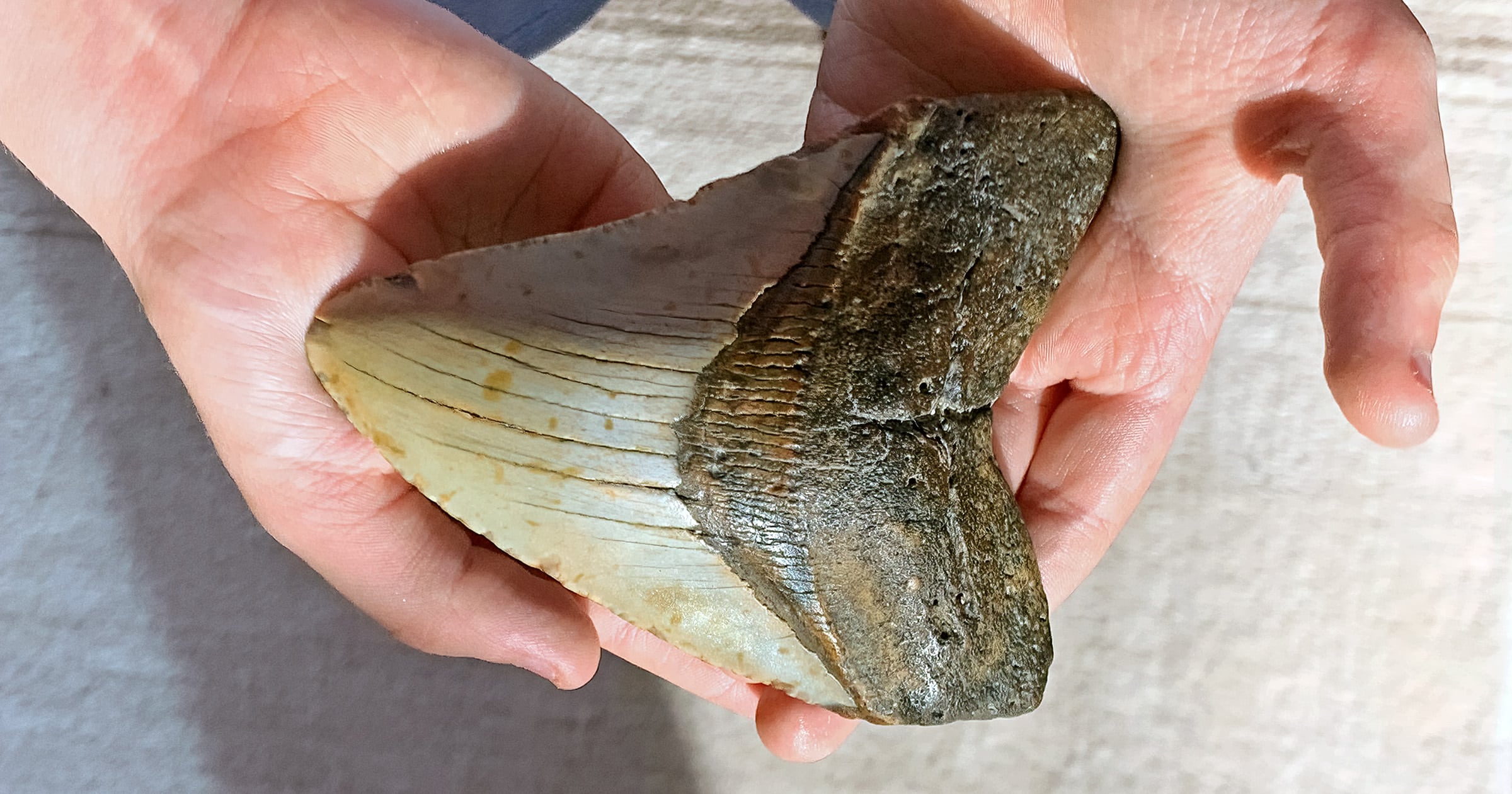 Intelligent Design
Intelligent Design
 Paleontology
Paleontology
#6 Story of 2022: Megalodon and Intelligent Design in Sharks

Editor’s note: Welcome to an Evolution News tradition: a countdown of our Top 10 favorite stories of the past year, concluding on New Year’s Day. Our staff are enjoying the holidays, as we hope that you are, too! Help keep the daily voice of intelligent design going strong. Please give whatever you can to support the Center for Science & Culture before the end of the year!
The following was originally published on August 26, 2022.
This week’s Fossil Friday features the tooth of a megatooth shark, Otodus megalodon (often you can still find the obsolete genus name Carcharocles). These fossil teeth are 3-7 million years old and were found at Morgan River in South Carolina, which is a famous locality for megalodon teeth. These fierce transoceanic superpredators (Herraiz et al. 2020, Cooper et al. 2022) had a worldwide distribution in the Miocene and Pliocene periods about 2.3-3.6 million years ago and could reach a size of more than 15 meters (Shimada 2019). This makes them three times larger than the biggest specimens of the famous great white shark, which reaches lengths of “only” 5-6 meters.
Megalodon was a specialized apex predator and fed mainly on large baleen whales. It was not closely related to the great white but rather to the mako shark, which means that the common reconstruction as superlarge great white is likely inaccurate (Cooper et al. 2020). New evidence suggests that outcompeting of the juveniles by adults of their smaller cousins may have played a role in their extinction (Boessenecker et al. 2019, Herraiz et al. 2020, McCormack et al. 2022). Nevertheless, tabloid journalists love to speculate that megalodon might still be around (e.g., O’Toole 2022), which of course is total nonsense.
Sharks (and/or stem chondrichthyans) appear very early in the history of vertebrate animals about 455 million years ago (Sansom & Smith 1996, Sansom et al. 2012, Davis 2020). Many fossil sharks are only known from their teeth, because these teeth are replaced in their revolver-like jaws and therefore often make it to the sea floor, where they can become embedded in sediments. Unfortunately, our knowledge of megalodon rests mostly on the giant teeth as well, with the exception of a single vertebral column and a chondrocranium (Cooper et al. 2022).
Sharks possess many remarkable biological features, of which some clearly point to intelligent design, such as their complex olfactory and electromagnetic sense organs. The latter are situated on and around their snouts and are called ampullae of Lorenzini (Bellono et al. 2017, Weiler 2017). The discovery of this electromagnetic sense by Adrianus Kalmjin is a fascinating story (Shiffman 2022). A recent study revealed further secrets, such as the fact that sharks only use these organs to find prey, while the related skates and rays also use them for electric communication (Weiler 2018). For more information on evidence for intelligent design in marine organisms like sharks and whales, I highly recommend the Illustra Media documentary Living Waters (Evolution News 2016).
References
- Bellono N, Leitch D & Julius D 2017. Molecular basis of ancestral vertebrate electroreception. Nature 543, 391–396. DOI: https://doi.org/10.1038/nature21401.
- Boessenecker RW, Ehret DJ, Long DJ, Churchill M, Martin E & Boessenecker SJ 2019. The Early Pliocene extinction of the mega-toothed shark Otodus megalodon: a view from the eastern North Pacific. PeerJ 7:e6088, 1–47. DOI: https://doi.org/10.7717/peerj.6088.
- Cooper JA, Pimiento C, Ferrón HG & Benton MJ 2020. Body dimensions of the extinct giant shark Otodus megalodon: a 2D reconstruction. Scientific Reports 10:14596, 1–9. DOI: https://doi.org/10.1038/s41598-020-71387-y.
- Cooper JA, Hutchinson JR, Bernvi DC, Cliff G, Wilson RP, Dicken ML, Menzel J, Wroe S, Pirlo J & Pimiento C 2022. The extinct shark Otodus megalodon was a transoceanic superpredator: Inferences from 3D modeling. Science Advances 8(33), 1–13. DOI: https://doi.org/10.1126/sciadv.abm9424.
- Davis J 2020. Shark evolution: a 450 million year timeline. NHM Website. https://www.nhm.ac.uk/discover/shark-evolution-a-450-million-year-timeline.html
- Evolution News 2016. Shark Knows with Its Nose Where It Goes in the Dark. Evolution News January 12, 2016. https://evolutionnews.org/2016/01/shark_knows_wit/
- Herraiz JL, Ribé J, Botella H, Martínez-Pérez C & Ferrón HG 2020. Use of nursery areas by the extinct megatooth shark Otodus megalodon (Chondrichthyes: Lamniformes). Biology Letters 16(11):20200746, 1–7. DOI: https://doi.org/10.1098/rsbl.2020.0746.
- McCormack J, Griffiths ML, Kim SL et al. 2022. Trophic position of Otodus megalodon and great white sharks through time revealed by zinc isotopes. Nature Communications 13:2980, 1–10. DOI: https://doi.org/10.1038/s41467-022-30528-9.
- O’Toole S 2022. Terrifying sighting of huge shark sparks debate about if megalodons still exist. Mirror May 14, 2022. https://www.mirror.co.uk/news/weird-news/terrifying-sighting-huge-shark-sparks-26921012
- Sansom IJ & Smith MM & Smith MP 1996. Scales of thelodont and shark-like fishes from the Ordovician of Colorado. Nature 379(6566), 628–630. DOI: https://doi.org/10.1038/379628a0.
- Sansom IJ, Davies NS, Coates MI, Nicoll RS & Ritchie A 2012. Chondrichthyan-like scales from the Middle Ordovician of Australia. Palaeontology 55(2), 243–247. DOI: https://doi.org/10.1111/j.1475-4983.2012.01127.x.
- Shiffman DS 2022. The Discovery of the Shark’s Electric Sense. American Scientist 110(3), 152. DOI: https://doi.org/10.1511/2022.110.3.152.
- Shimada K 2019. The size of the megatooth shark, Otodus megalodon (Lamniformes: Otodontidae), revisited. Historical Biology 33(7), 904–911. DOI: https://doi.org/10.1080/08912963.2019.1666840.
- Weiler N 2017. Study Shows How Skates, Rays and Sharks Sense Electrical Fields. UCSF March 6, 2017. https://www.ucsf.edu/news/2017/03/405996/study-shows-how-skates-rays-and-sharks-sense-electrical-fields
- Weiler N 2018. Electric ‘Sixth Sense’ Evolved Differently in Sharks and Skates. UCSF May 31, 2018. https://www.ucsf.edu/news/2018/05/410601/electric-sixth-sense-evolved-differently-sharks-and-skates
